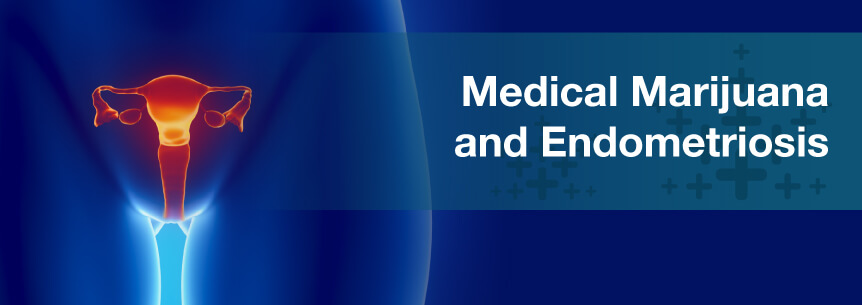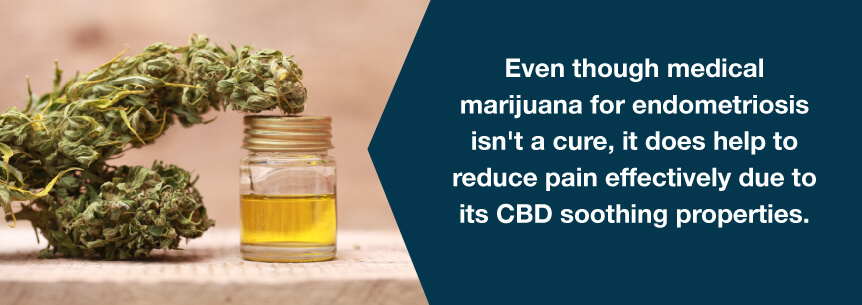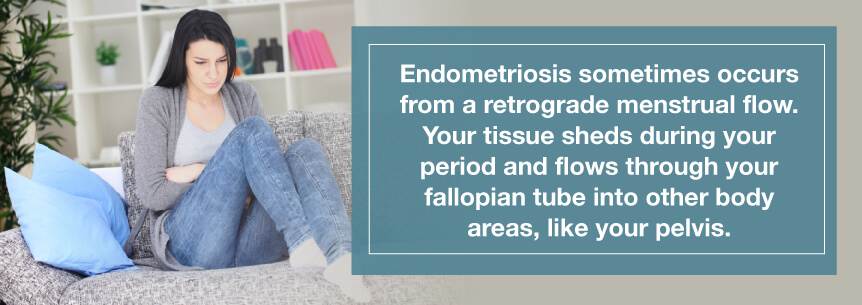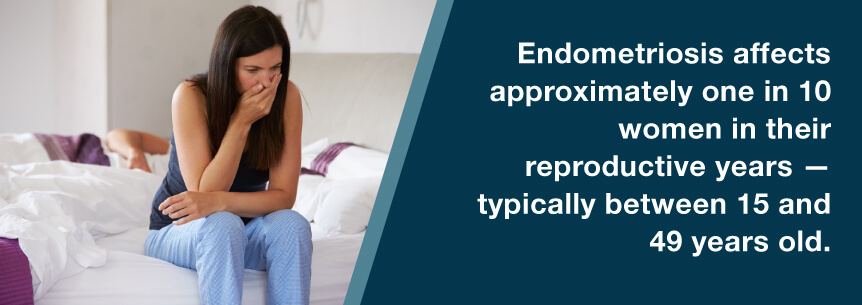
Endometriosis affects approximately 176 million women in their reproductive years worldwide. It can make it difficult to become pregnant, and it can also bring on a lot of pain and other symptoms. There are treatments, however, to help manage the effects of the condition, including medical marijuana for endometriosis. Other therapies can improve your likelihood of becoming pregnant.
Analgesic pain relievers and anti-inflammatories are the most common method of treating the pain resulting from endometriosis. However, there are also more natural, alternative treatments like cannabinoids, for instance.

Even though medical marijuana for endometriosis isn’t a cure, it does help to reduce pain effectively due to its CBD soothing properties.
Find A Doctor Find A Dispensary
A study conducted at UCSF showed cannabinoids combined with opiates resulted in greater reduction of pain with a lower dosage of opiates than if the subjects didn’t use cannabinoid. Chronic pain sufferers in this study reported up to a 33 percent reduction in pain despite being given a lower dose of their opiate pain relievers. Dr. Donald Abrams states their next step is to do another study including different medical marijuana types and potentially placebos so the results of this study can be confirmed.
The pain produced by endometriosis can only be described as chronic if the underlying condition is not treated. Therefore, long-term treatment is necessary. Over time, women who are taking prescription medications can become addicted to or experience less relief from these pain relievers. While tolerance to medical marijuana may increase over time, the risks of medical marijuana are far fewer than those of opiates.
There is no known risk of death from marijuana overdose or overuse, and it is not for lack of research. People have been using marijuana for thousands of years, and there is not one single documented case of a medical emergency resulting from an overdose.
Everyone has an endocannabinoid system (ECS). This system contains CB1 and CB2 receptors, and in women, it is concentrated mostly in the uterus. Women with endometriosis have a CB1 production deficiency, making medical cannabis a good treatment option to relieve the pain by activating the CB1 receptors. Plus, unlike other treatments, weed doesn’t produce the harsh side effects.
When it comes to endometriosis, women can experience painful periods at any time with:
In addition to intense pain, many women also experience extreme irritability, vomiting and fainting.
Marijuana has long been considered a treatment for pain management. There is also some evidence to suggest medical cannabis is helpful to use with opiates to keep opiate dosage low, and it appears to increase the effectiveness of opiates’ pain reducing abilities as well.
Medical marijuana is unlikely to work in the treatment of endometriosis itself. There is not any evidence to suggest medical marijuana can decrease the production of the uterine lining to any significant extent. Therefore, the only use medical marijuana can have in the treatment of endometriosis is in pain management. Numerous studies show medical marijuana has some pain-relieving properties appearing to vary by individual. Some people can experience significant relief from pain on medical marijuana, and others experience very little or none. Like all medications, people react in different ways.
The cannabis plant’s cannabinoids can help alleviate most of your endometriosis symptoms such as:
Those interested in using medical marijuana and endometriosis treatment to relieve their symptoms could benefit the most with marijuana strains high in CBD.
CBD isn’t psychoactive like THC and still provides relief from pain and inflammation for a whole range of medical conditions, including endometriosis and is a good starting point. Some strains include:
Some other cannabis and endometriosis strains you can try include:
Of course, talking with a qualified cannabis doctor will help you decide which cannabis for endometriosis strains will be most effective for your pain and other symptoms.
Below are some preferred delivery methods of your marijuana and endometriosis treatment:
Women with endometriosis who are receiving hormonal treatments should not smoke — this includes smoking marijuana. You risk of deadly blood clots increases when you smoke. If you want to inhale your medical cannabis for endometriosis treatment, use a vaporizer instead.

Smoking weed, like cigarettes, releases toxins which can not only diminish the healing properties of the cannabinoids, but it can also irritate the lungs. Vaping medical marijuana heats the air around the herb and releases an array of cannabinoids — all with their unique health benefit.
Consuming cannabis oil doses can be an option if you’re looking to switch to cannabis from pills. Cannabis oil can come in capsules, making it easier to swallow and obtain the correct dosage.
You may also buy a preloaded oil syringe you squirt inside your mouth or place drops of a cannabis tincture under your tongue.
Consuming edibles like candy, brownies or cake infused with cannabis can help with sleeping issues.
Medical weed topicals are lotions, balms or creams you apply to your skin. You may use these to relieve your back or pelvic pain.
A transdermal patch is a discreet way of getting cannabis into your body. Patches are similar to nicotine or birth control patches. They’re a great option if you aren’t comfortable with vaping.
Juicing raw cannabis helps reduce endometriosis-related inflammation and pain without the psychoactivity of heated marijuana.
Many U.S. states are legalizing medical cannabis for patients looking for relief from chronic pain. You simply apply for your medical marijuana card. This means more individuals will finally receive the pain relief and management they desperately need.
To obtain your card, you’ll need to set up an appointment with a cannabis doctor who will assess your symptoms and see if you qualify.
To begin your marijuana for endometriosis treatment, you can browse our extensive database to look for a cannabis dispensary and find a medical marijuana doctor.
Find A Doctor Find A Dispensary
Endometriosis is a disorder where your endometrium — tissue lining the inside of your uterus — grows outside of your uterus. It can be painful and mostly involves your pelvic tissue, ovaries and fallopian tubes. It hardly ever spreads past your pelvic organs.
With this condition, you have displaced endometrial tissue still acting as it should normally. It becomes thick, breaks down and begins bleeding with each of your menstrual cycles, but it becomes trapped because it can’t exit your body. When endometriosis involves your ovaries, endometriomas (cysts) can form, irritating surrounding tissue and leading to adhesions and scar tissue.
The pain with endometriosis can sometimes become severe, particularly when you’re on your period, and you may develop fertility problems as well.
The main endometriosis symptom is pain in your pelvic area, typically associated with your period. While most women have cramps during their menstrual flow, when you have endometriosis, the pain is much worse than normal and may increase over time.
Common endometriosis symptoms may include:
Your pain severity isn’t the greatest indicator of the extent of endometriosis. Some women have intense pain even with mild endometriosis, while others have very little pain or none at all with advanced endometriosis.
Nobody knows what causes this condition for sure. However, potential causes may be:

Several types of endometriosis exist. If you receive a diagnosis, your doctor will discuss the type you have with you. When you know the details about the kind of endometriosis you have, it will not just help you make an informed decision regarding your treatment, but it also provide you with knowledge about your condition which will empower you. The different types include:
Using histological endometrial activity and structure parameters, Cullen was the first scientist to define peritoneal endometriosis as “adenomyoma.” Rokitansky described an adenomatous polyp (a form of adenomyosis) first.
Early ovarian endometrioma descriptions as “chocolate cysts” or “hematomas of the ovary” go back as far as the end of the 19th century. In 1899, Russel published “ovary containing uterine mucosa,” but the first to exhibit specific endometrial activities like decidualization in pregnancy and desquamation during menstruation was Sampson — he afterward presented his theory on its development.
Complications of endometriosis may include:
To avoid future complications, it’s important you see your doctor.
Psychological factors help doctors determine how severe symptoms are. Women suffering from endometriosis report high incidences of depression, anxiety and other psychiatric conditions, and these high levels of depression and anxiety may intensify the severity of pain.
Some studies show women with endometriosis who are sleep deprived can struggle with metabolic and hormonal changes as well as increased levels of pain and inflammation.
According to The American College of Obstetricians and Gynecologists (ACOG), endometriosis statistics include:

While there’s no cure for endometriosis, you can manage its symptoms.
Treatment options may include:
OTC medicines like ibuprofen (Motrin IB, Advil), naproxen (Aleve) or acetaminophen (Tylenol) are potential pain relievers, but they aren’t always effective.
Side effects of these pain medications may include:
These prevent monthly endometrial tissue growth and buildup resulting in decreased fertility. Birth control patches, pills and vaginal rings may also reduce or even eliminate pain in cases of mild endometriosis.
Depro-Provera (medroxyprogesterone injection) is another option to stop menstruation. It prevents endometrial implant growth and alleviates pain and other symptoms. You may want to consider other options first since this injection can increase your risk of:
You may relieve your pain or even stop its progression by taking supplemental hormones your doctor prescribes to you. Hormonal therapy will help your body regulate monthly hormone changes promoting tissue growth with endometriosis.
Danazol is another medicine doctors prescribe to reduce symptoms and stop menstruation. However, even when you take this medication, the condition can continue to progress. Some side effects of Danazol may include hirsutism — abnormal hair growth on the body or face — and acne.
Females take GnRH antagonists and agonists to block ovary-stimulating estrogen production. Estrogen is a hormone in your body mostly responsible for developing women’s sexual characteristics. This creates artificial menopause and prevents menstruation. You may experience side effects like hot flashes and vaginal dryness, but you can reduce or prevent these symptoms by taking small doses of progesterone and estrogen together.
Conservative surgery is an option if you are experiencing severe pain, want to become pregnant or if hormonal treatments aren’t effective. Doctors perform this surgery to destroy or remove endometrial growths without causing reproductive organ damage.
Another minimally invasive surgery, laparoscopy, helps the surgeon view, diagnose and eliminate the endometrial tissue. They’ll make small abdominal incisions to surgically cut out the growths or vaporize or burn them. These days, lasers are becoming more common as a way to eliminate this displaced tissue.
Your doctor may suggest this surgery only as a last resort if other treatments aren’t improving your condition. Your surgeon will remove your cervix and uterus during a total hysterectomy. They’ll also remove your ovaries since these produce estrogen which causes endometrial tissue growth. They’ll also remove any noticeable implant lesions.
Again, surgeons typically only go this route when other treatments aren’t working and when your inflammation and pain are affecting your quality of life. A hysterectomy stops your menstruation cycle and reduces endometriosis symptoms, but there isn’t any guarantee it will eliminate your pain entirely.
A hysterectomy will also eliminate your chances of becoming pregnant. Therefore, you’ll want to obtain a second opinion and consider all your options carefully before you agree to this surgery if you want to start a family.
Newer treatments are being introduced such as:
Scientists and the medical community need to conduct further research into local neurogenesis, central sensitization and endometriosis genetics to identify other targets of treatment.
New surgery developments have also shown how useful endometriosis robotic surgery can be — though these methods aren’t necessarily better than conventional laparoscopy. Also, researchers are studying narrow band imaging, fluorescence imaging and other enhanced imaging techniques, but these haven’t demonstrated any long-term clinical benefits as of yet.
A broader range of treatment options opens the door for a more personalized treatment plan and the possibility of precision health for women with endometriosis.